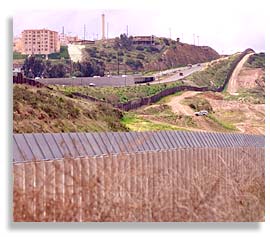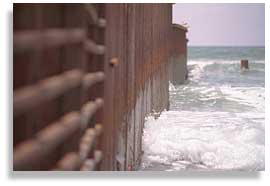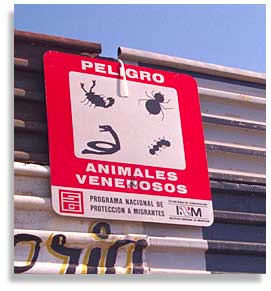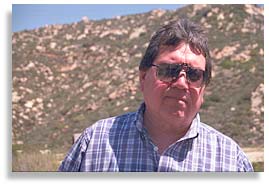|
Interview with Roberto Martinez (1999)
U.S. Border Patrol in S. California Developing Deadly But Ineffective Operation Gatekeeper 418 men, women and children die in 4 years, in California, crossing U.S. / Mexico border San Diego, California
Roberto Martinez is director of the U.S. / Mexico Border Program and Immigration Law Enforcement Monitoring Project of the American Friends Service Committee. In 1992, he became the first U.S. citizen to be honored as an International Human Rights Monitor by the international human rights organization Human Rights Watch. He has been a Chicano civil rights and human rights activist for the past 20 years. The interview was conducted (and edited) for In Motion Magazine in San Diego, June - August, 1999 by Nic Paget-Clarke. In Motion Magazine: What is Operation Gatekeeper? Roberto Martinez: Operation Gatekeeper is supposed to be patterned after Operation Hold the Line, or the Blockade as we call it, in El Paso, -- the very first Border Patrol strategy of concentrating agents on the border. But because the terrain here is not flat like El Paso’s, here we have gullies and canyons, they really couldn’t do it the same way - lining up agents along the border shoulder to shoulder so to speak. So they decided on a different strategy of three tiers of agents at the border. Not as concentrated as it sounds but a row of agents along the border fence, another one a few hundred yards behind, and another several hundred yards behind that. Although I’ve never seen that actually done, this is what they call Operation Gatekeeper. It’s a concentration of agents in a specific area trying to discourage people from crossing. It is in conjunction with the border fence which is a ten foot high steel wall, and with Congressman Hunter’s plan for a triple fence. The triple fence utilizes the first fence/steel wall and then a second one that has already been built, fifteen foot high, and a third one to come later, a ten foot high chain link fence. There will be three rows of fences basically patterned after Operation Gatekeeper’s strategy of three tiers of people or barricades, whatever they decide to put up. In Motion Magazine: What has been the effect? Roberto Martinez: So far Operation Gatekeeper has been in effect since 1994 on the San Ysidro border and part of Otay Mesa border. Over the last couple of years we have begun to see a shift of migrants from the San Ysidro / Otay area to the east county because of the difficulty in crossing now at San Ysidro / Otay. This is primarily because of the double walls that they have now, and the lights, the sensors, all the technology that they have thrown at that border. Since the main objective has been to shift migrants to the east County where according to the Border Patrol and the INS they’ll be easier to apprehend out in the open, as opposed to down here, and the urban area of San Ysidro and so on, the effect has been that it has caused a dramatic increase in the people dying crossing the border because of the mountains and the desert. Deaths are attributed to the heat in the deserts during the summer, and those numbers have quadrupled over the last four years since Operation Gatekeeper began. Prior to 1994 we documented 20 to 30 deaths a year. Now it’s 145, as of last year. 145 a year. Most of the deaths are caused by heat in the desert in the summer, drowning in the All American canal and hypothermia in the mountains. Even in the summer months it gets very cold in the canyons. When you cross the border in the Campo area you are almost up to the 2,000 foot level already. Many large groups of migrants have been found (14, 15, 16) caught in the snow and rain up to the 4,000 foot level, Mount Laguna. They get lost. Or they get abandoned by the coyotes, the smugglers. I just heard recently that during the summer a lot of them died from snake bites and other kinds of infections from animal bites.
And I’m only talking about the California border right now. Hundreds more die in the Texas and Arizona border areas. Basically from exposure. Death toll total for four years In Motion Magazine: What is the death toll total for those four years? Roberto Martinez: As of last week it’s 418 men, women and children. In Motion Magazine: Who’s in charge of Operation Gatekeeper? Roberto Martinez: The Border Patrol is in charge of implementing it and enforcing it. In Motion Magazine: They coordinate other agencies? Roberto Martinez: The military if they are there, they are in charge of them. In the shooting of that 18-year old U.S. citizen kid, Ezequiel Hernandez, a couple of years ago in Redford, Texas. The JTF6, the U.S. Marine Corps from Camp Pendleton were over there conducting their drug surveillance and they shot Ezequiel Hernandez. But they had to report everything to the Border Patrol. In fact, the ultimate decision to shoot the boy was approved by a Border Patrol supervisor. They oversee any operations on the border. In Motion Magazine: Who is charge of the Border Patrol? Roberto Martinez: They are the armed branch of the INS, the Immigration and Naturalization Service. Their ultimate boss is Doris Meisner, the INS Commissioner in Washington. But they have regional directors. Here they report directly to the Laguna Niguel INS western regional director. He in turn reports to Meisner in Washington. In Motion Magazine: The local city attorney plays no role? Roberto Martinez: Only the U.S. attorney. And they are all under the Justice Department. The U.S. attorney here reports to Janet Reno, the U.S. Attorney General in Washington, D.C. Doris Meisner also reports to her. Ultimately Janet Reno is the boss. And she reports to Clinton and Congress.
Roberto Martinez: For sure we wouldn’t have the number of deaths we have now. But there would still be human rights abuses. For example last September the Border Patrol shot four migrants here in San Ysidro, killing three of them. Supposedly for threatening to throw rocks. They didn’t throw any rocks, but they shot and killed them anyway. Many of the shootings that we see here over the years the migrants were running back to Mexico and were shot in the back. We have documentation going back for almost twenty years where they have shot Mexican migrants at the border fence. I remember in the early eighties some times 4 to 6 a week, three or four in one day. In the late 1970s and early ‘80s they were experimenting here with what was called the Border Crime Prevention here. Made up of half Border Patrol and half SDPD (San Diego Police Department) police dressed in civilian clothes to mingle in the hills of the border here in San Ysidro and Otay. Basically to use them selves as decoys to draw out bandits who were robbing, killing and raping migrants crossing the border. But because they were dressed in civilian clothes they unfortunately fooled migrants into thinking they were being robbed and would pick up a stick, something to defend themselves, and they would in turn be shot and killed. Nobody knew who was who. In fact, the police and the Border Patrol even shot at each other and were wounded, but they had flack jackets (bullet proof vests). It was chaos at the border from the late seventies till the early 90s. They were finally disbanded because we here helped file dozens of lawsuits on the shooting and beatings. They were disbanded in 1989. In the early ’90s, they were reinstated as the Border Crime Intervention Unit but the Border Patrol and police would not work together because we put pressure on them for the shootings. They decided to work separately. There were several shootings, killings, in the early 90s by the Border Patrol. And after 93 and 94 there weren’t any more shootings until the last couple of years. There was the perception that they were trigger happy - which they were. But like I said the human rights abuses go on almost every day somewhere on the border between here and south Texas. and that’s what our new report is about. The first dozen pages or so are a memorial to the three hundred or so migrants and how they died. Rapidly approaching four hundred. Ineffective in stopping the flow of people In Motion Magazine: Has Operation Gatekeeper had any impact on the number of people who cross the border? Roberto Martinez: I sent a letter to Attorney General Reno and pointed out that Operation Gatekeeper is not only causing one of the worst human rights tragedy in border history, but it’s totally ineffective in stopping the flow of people in crossing the border. All they are doing is moving them from San Ysidro and Otay to east county, and Imperial Valley and into Arizona where the number of apprehensions has quadrupled. The same number of people are crossing - just in another area. They are touting the success of Operation Gatekeeper because they’ve reduced the number of apprehensions in this area, but it’s very deceptive. It a bubble effect, you squeeze here and they pop up over there. They are still stopping van loads in San Clemente and Temecula, and finding two or three hundred people in a drop-house here in barrio Logan. In Motion Magazine: Two or three hundred in one house? Roberto Martinez: Absolutely. It’s very tragic. I see pictures of them on the floor in every corner of the house. Men, women and children. Unfortunately a lot of them have been abandoned and they spend days without food and water. Very tragic. But that’s just to point out that people are coming through. I’ll tell you something else, they have arrested and indicted several INS and Border Patrol agents for taking bribes and allowing van loads of people to come across at the port of entry. Indicted by the U.S. attorney. There’s a lot of corruption on the border. Over the last twenty years hundreds of customs and border patrol agents have been indicted for taking bribes to allow smugglers to bring over not only people but also drugs, cocaine. Just a year ago, at Campo, a Border Patrol agent was caught by other Border Patrol agents with eight duffel bags full of marijuana in his bronco (white Border Patrol utility vehicle). He had been part of a smuggling ring in that area for who knows how long. It was in the paper.
Roberto Martinez: No. But the government has been quick to lump them all together to justify sending the military to the border, and increasing the Border Patrol. Reno has even gone as far as declaring the border a threat to our national security because of terrorists and drugs and because of illegal immigration - they lump them all together. There’s a distinct difference between economic migrants and drug traffickers and so on. Most of your drug trafficking, heavy duty cocaine comes through the port of entry with the help of corrupt agents. But not through the hills. I’m sure there’s some marijuana, but it would be very hard with the number of Border Patrol agents out there now. You have to remember there’s close to 2,500 just in the San Diego sector of the border, and most of them are concentrated in the east county. The total U.S./Mexico border has close to 8,000 agents. In Motion Magazine: What’s the estimated traffic of migrants? Roberto Martinez: It’s hard to say because the Border Patrol controls the numbers. In Motion Magazine: What do they say? Roberto Martinez: They say something like 250,000 a year. Total along the border they estimate close to a million. Around the country, INS figures say 5 million. In Motion Magazine: Are the majority of the migrants going to agricultural work? Roberto Martinez: No, I think only about 10 or 15 percent. The majority are going into factory work. Construction and factory work are more appealing, they are higher paid. The less-skilled are traditional migrant farm workers and they end up here, and north county, and the Central Valley. Many are coming here for that from Chiapas, Oaxaca, and Guatemala. We have a large Guatemalan community here. And Mixtec people who are now quite organized into a union or association throughout the state. They have formed an alliance of indigenous people that extends from Oaxaca to Baja California to California. Their alliance is of farmworkers and their purpose is to educate themselves about their rights and protect each other. They have tens of thousands of members. In Motion Magazine: To what extent do people re-cross the border, or circulate? Roberto Martinez: What has happened now with the difficulty of crossing the border is more are staying in the United States. Human rights people in Mexico tell us that at one time people could make it across the border in three of four tries. Now it takes up to two weeks, and in San Ysidro it’s almost impossible. Also it’s now more expensive. It used to cost three hundred and fifty or four hundred dollars, now it’s over a thousand per person. Of course they don’t have that kind of money. They have to work it off. This is what most smugglers do. They do it with the Chinese, the Koreans, and they do it with the Mexicans and Central Americans. Many migrants are the victims of extortion and kidnapping and rape. The sad thing is they get it all the way up through the mainland of Mexico. Extortion from the cops, immigration, soldiers, and by the time the get to the border they are almost broke. That adds to their burden. and then on top of that there’s the Border Patrol abuses. In Motion Magazine: Who are the U.S. officials at the border crossings? Roberto Martinez: The ones in the booths, Primary Inspection, are Customs, under the Treasury Department. They are the ones in blue shirts. The INS are in Secondary Inspection with Customs. White shirts are INS. The green uniform is the Border Patrol. And for several years now, the ones in camouflage are National Guard. They backup customs and in the desert they assist in the search for drugs. In Motion Magazine: How does Operation Gatekeeper fit into the national immigration policy? Roberto Martinez: It’s only a border strategy. There’s nothing like that in the interior. There’s Operation Gatekeeper in San Diego and Imperial Valley. There’s Operation Safeguard in Arizona. In El Paso there is “Hold the Line”. The latest one is Operation Rio Grande in the south Texas area, Harlingen and Brownsville. These are all designed to push people into open areas where they can be more easily apprehended. Which of course is resulting in this tragedy. In Motion Magazine: What do the employers think of all this? Roberto Martinez: They fall under the 1986 strategy of sanctions where they would be fined $1,000 for every migrant who cannot verify his status. And up to $10,000 for a third offense, or 6 months in jail. But that hasn’t stopped employers from hiring undocumented people. They are getting fined right and left, but it’s a strategy that is not working. It hasn’t been enforced to the extent that we thought it would. But that’s more like an interior enforcement area.
In Motion Magazine: What policies do you recommend? Roberto Martinez: We have recommended to the government that they suspend these operations, particularly Gatekeeper, and reevaluate the circumstances. There is no solution. The only ultimate solution is for Mexico to develop its economy to the extent that they can pay a living wage to their people so they don’t have to cross the border. That’s long term. With the corruption of the current Mexican government I don’t see that happening, at least not in this life time. Economic factors being what they are in Mexico, the devaluation of the peso, the growing increase in food prices ... they can put five walls up fifty feet high and still people are going to come. They are going to dig around it, under it. They are coming across in boats now which is something that wasn’t happening before. They are coming across in fishing boats. They are being caught at Mission Beach, Mission Bay by the Coast Guard and the Border Patrol. They will find a way. It would almost be impossible to connect these walls for two thousand miles. The most ingenious one I heard of was the car-transport trucks with two layers that just backed up to the wall and vans just drove off the top. Another famous example was the Otay Mesa tunnel which was almost a mile long. It’s like the Berlin Wall, when you are desperate and hungry - you are going to find a way across. They killed hundreds of people at the Berlin Wall, and that’s what they are doing here. It needs to be seen in a worldwide context of people migrating across borders to escape civil war, hunger and poverty. It’s happening in Kosovo, Africa, Central America. Everyday people are crossing borders for the same reasons that these people are. And nothing stops them, short of genocide, such as in Africa and Kosovo. But people here are primarily economic migrants. In Motion Magazine: To what extent is it a military operation? Roberto Martinez: These are not military operations. The only thing that is military is the technology, and the firepower. |
||||||||||||||||||||||||||||||||||||||||||||||||||||||||||||||||||||||||
|
Published in In Motion Magazine - December 12, 1999. Also see:
|
||||||||||||||||||||||||||||||||||||||||||||||||||||||||||||||||||||||||
If you have any thoughts on this or would like to contribute to an ongoing discussion in the  What is New? || Affirmative Action || Art Changes || Autonomy: Chiapas - California || Community Images || Education Rights || E-mail, Opinions and Discussion || En español || Essays from Ireland || Global Eyes || Healthcare || Human Rights/Civil Rights || Piri Thomas || Photo of the Week || QA: Interviews || Region || Rural America || Search || Donate || To be notified of new articles || Survey || In Motion Magazine's Store || In Motion Magazine Staff || In Unity Book of Photos || Links Around The World NPC Productions Copyright © 1995-2020 NPC Productions as a compilation. All Rights Reserved. |
||||||||||||||||||||||||||||||||||||||||||||||||||||||||||||||||||||||||






